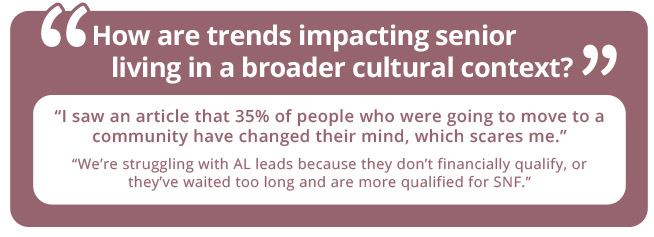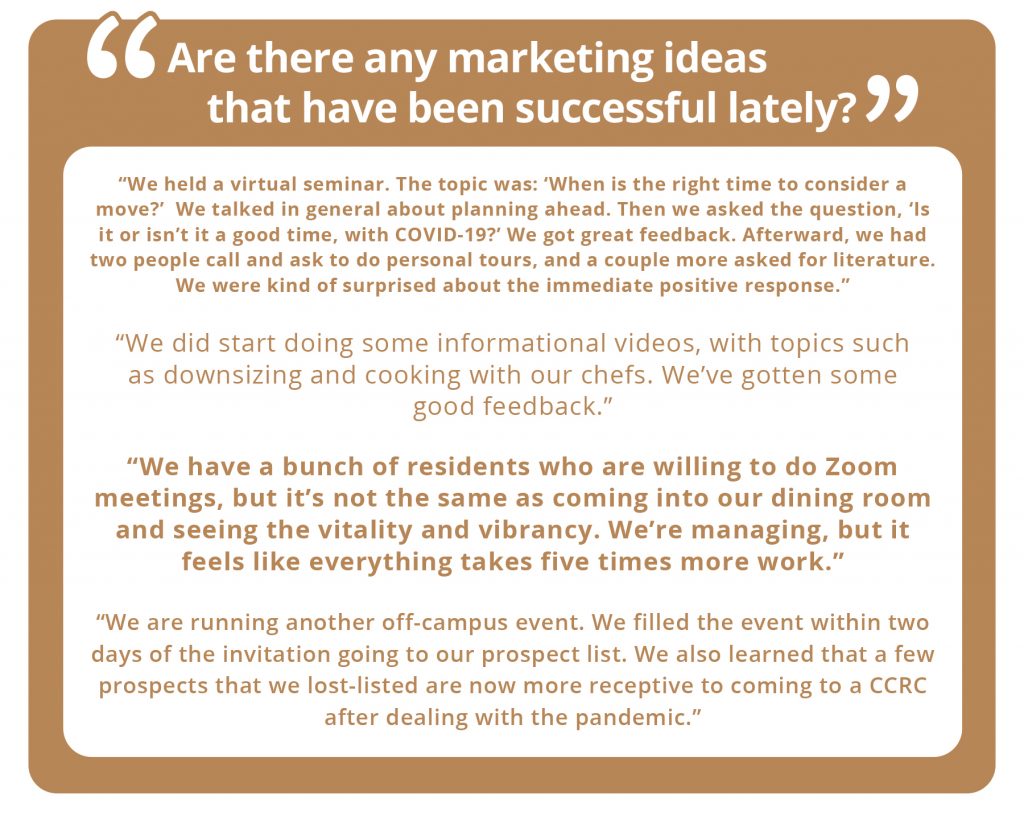I’m Renee Kelly, and I’m an art director at Varsity. I design all kinds of advertising for Varsity’s clients — including the blogs for the weekly COVID-19 sales & marketing roundtables. Attending the roundtables has impacted my point of view on the pandemic: I’ve seen up-close its effects on communities, staff and vulnerable residents. For me, the last 9+ months of roundtables have become an unofficial timeline of the COVID-19 crisis in our industry.
When the pandemic first hit, there were so many unknowns. We didn’t know how bad it would get, or how much it would impact seniors. Marketing came to a halt when everyone quickly realized that the traditional tools like tours and in-person events wouldn’t work. The focus shifted to be less on occupancy and more on keeping residents safe and healthy. At Varsity, we also had to quickly shift our focus to better suit our clients’ changing needs.
One thing that struck me from early on were concerns about isolation, especially for residents in memory care. One quote:
WEEK 3: “Those with cognitive impairment don’t understand the situation and feel that they are being punished in their rooms.”
That was specifically the quote that hit me the hardest, and has stuck with me over the last nine months.
Soon after that, communities started reporting their first cases in residents and staff:
WEEK 4: “We have our first positive case and we are working with Varsity on a communications plan.”
Through all of the uncertainty, communities (even competitors) were working together. A community on the West Coast and a community on the East Coast even planned to connect after one call to discuss a shared challenge.
We gradually got into the groove of the “new normal” and communities started to plan virtual events. At a little over three months, we realized we were probably in it for the long haul.
WEEK 14: “There is no ‘end of COVID’ that we can see.”
The issue of family, and how to safely visit, came up time and time again. From drive-by visits to video calls, communities tried everything.
WEEK 22: “Residents are lonely and want to be around family.”
The next few weeks added additional stresses to 2020.
WEEK 26: “We’re discouraged — now we have fires! One of the fires is cutting off the entrance of our new community, so people can’t visit.”
COVID-19 had crept into a few of the communities of those on the calls.
WEEK 34: “I feel blessed and fortunate. We’ve only had 6 cases, 5 of which were employees. Cases are going up around us, but we’ve managed to stay safe.”
We were hearing a broad range of emotions. People wanted to be optimistic, but were fearful of letting down their guard. And, as communities found creative ways of reaching seniors who were feeling isolated at home, occupancy began to rise.
WEEK 35: “We’ve sold four apartments in October due to concessions offered, eight since we started the concessions at the end of August.”
Where are we now? In many states, the numbers are going in the wrong direction.
WEEK 36: “We were so proud that we kept COVID-19 out of here until this last week. It’s having a whole new impact on us.”
But communities are feeling hopeful as the vaccine has received approval.
WEEK 37: “We’re hoping that a vaccine can help us turn the corner.”
During the COVID-19 pandemic, I feel that Varsity’s roundtables have given communities a place to come together to share ideas, successes and concerns, or just vent. And the emails and survey responses people have sent seem to confirm that:
“Appreciate you and the Varsity team taking the time to coordinate these calls and share with all of us!”
“Thank you for setting up these very informative roundtable discussions. We will be applying much of what you have recapped.”
“I greatly appreciate the communication and listening to peers facing the same challenges.”
“Thank you for hosting this. Got some great ideas that I hope we can implement with the city on Safer at Home order. Nice to learn what other communities are doing.”
“This roundtable has grown into a staple for these times and I think that everyone is enjoying the opportunity to share and learn.”
“I am buoyed by reading the notes from the meetings knowing we are all in this together.
Personally, the roundtables have had far more of an impact on me emotionally than I thought they would, and I’ve put that emotion behind the work we’re doing. With everything that our clients are now facing, I’m proud that Varsity is part of the ongoing solution. I know that my co-workers at Varsity feel similarly.
Here’s to a new year filled with happy news, and we hope you can join the conversation as we continue our roundtables in 2021. To join us on Thursdays at noon ET, email DDunham@VarsityBranding.com for login information.
































